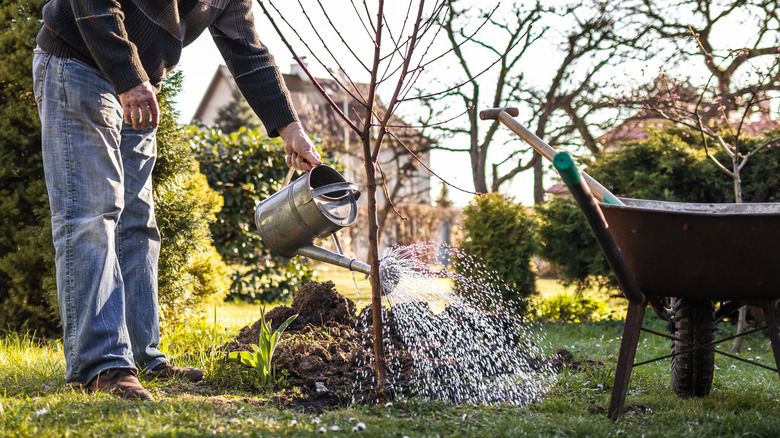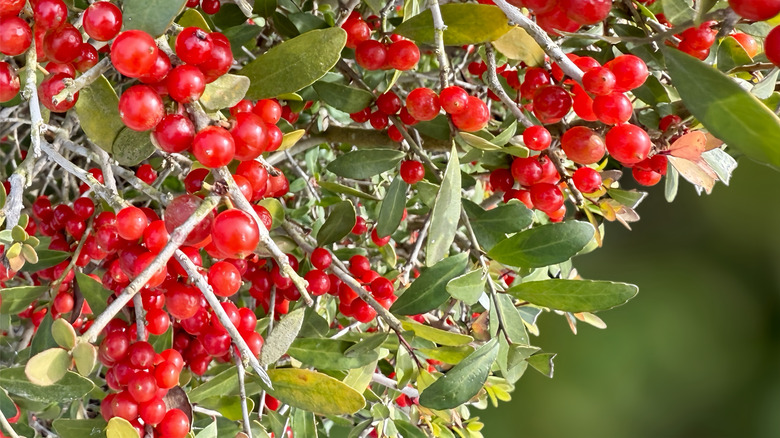Attracting Birds & Bees Is Easier When You Grow This Berry-Producing Plant They Love
We may receive a commission on purchases made from links.
Are you an avid backyard birder who also abhors mess? You're likely looking for ways to bring more birds into your yard that don't involve bird seed spilling all over your lawn. Or perhaps you need more bees to visit your vegetable garden to pollinate the cucumber vine rapidly overtaking your trellis. It turns out that native plants that are perfect for bringing birds to your yard with their tasty berries and shelter often boast blooms that also attract bees. One such plant is silver buffaloberry, a native shrub that attracts honey bees (and bonus, fuzzy bumblebees) to your yard with its pollen-filled blooms and birds with its tasty, bright red berries and thickets perfect for nesting safely within.
Silver buffaloberry (Shepherdia argentea) is native to the western United States and, like other native plants, offers lots of benefits for native birds. The thicket-like growth and thorny branches shelter birds and their nests and chicks from predators. Birds, from songbirds to the sharp-tailed grouse, in particular, rely on the berries for food. You need both a male and female silver buffaloberry tree to produce berries. Keep this fact in mind if you live in an area devoid of these shrubs in the wild or on neighboring properties. This hardy deciduous shrub is also perfect for gardeners wanting to start a pollinator garden. Bees, from honey bees to bumblebees to native bees, are drawn to the conspicuous yellow-hued male flowers. In fact, it boasts a Xerces Society Special Value to Native Bees designation. Note that you shouldn't plant this shrub near a pond; the saponins in the berries, while relatively harmless to mammals (including humans), are toxic to fish.
How to get and plant a bird and bee magnet silver buffaloberry shrub
Now that you know why silver buffaloberry regularly lands a spot in lists of top shrubs that will attract birds to your yard for fun feathered sightings (not to mention its bee-attracting potential), it's time to get your hands on one. Local or national nurseries specializing in native plants are your best bet for finding live plants, or ask your local native plant society for purchase advice. Though planting a silver buffaloberry sapling propagated from cuttings works best, you can also grow a shrub from treated (scarified) seed. A packet of 100 CZ Grain Store Silver Buffaloberry Seeds for Planting costs about $10. Directly sow the seeds into your garden in September in half-inch-deep holes. Note, however, that in the wild, seeds dispersed by berry-eating birds rarely germinate.
Plant silver buffaloberry in full sun to partial shade in any type of soil. This pretty shrub might even improve your soil; its mat of rhizomatic roots fixes nitrogen and stabilizes the earth. Silver buffaloberry will tolerate a lot of cold — down to Hardiness Zone 2, in fact — and survives dry spells with ease. It can reach heights of 20 feet in the best conditions, making it the ideal shrub for windbreaks, barriers, borders, or hedges. While silver buffaloberry might sound like an ideal addition to your backyard, the plant isn't without a few notable downsides. Its thorn-covered branches may be unsafe for children, pets, or gloveless gardeners. And despite being a native plant, silver buffaloberry grows rooting suckers that will quickly take over an area if they're left to grow.

